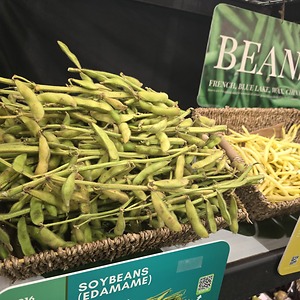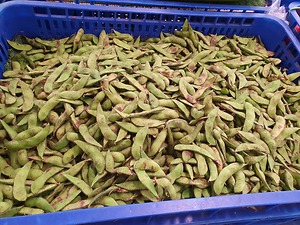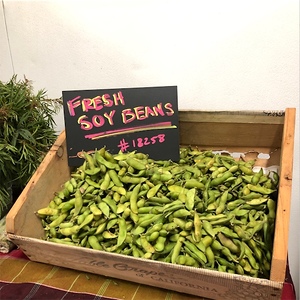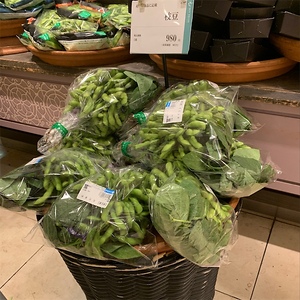

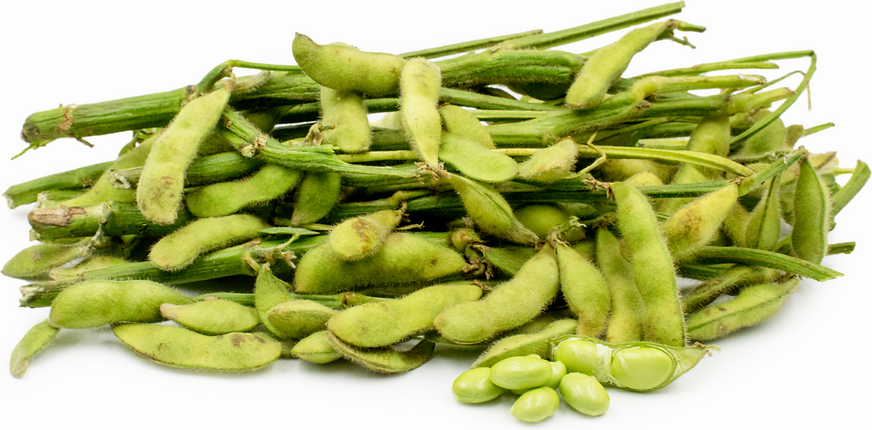
Soybeans
Estimated Inventory, lb : 0
Description/Taste
Soybeans are small legumes that grow on bushy green plants reaching up to 2 meters in height. Each pod measures between 3 and 8 centimeters long and grows in small bunches of three to five. The pods range in color from green to light yellow, gray, brown, and black. They are covered in tiny white hairs, giving them a fuzzy texture. Inside the pods are 2 to 4 seeds about 5 to 11 millimeters in diameter each. These starchy beans can be green, light yellow, brown, white, or black and have a shiny, firm, and smooth texture. When bitten into, the beans easily split in half. Soybeans have a grassy, bean-like scent. Their taste is buttery, nutty, and slightly sweet.
Seasons/Availability
Soybeans are harvested in the fall and available year-round.
Current Facts
Soybeans are botanically classified as Glycine max and belong to the Fabaceae family, which includes peas, legumes, and beans. Soybeans are also referred to as Soja beans or Soya beans. As the leading source of vegetable protein, they are often used in vegetarian foods due to their hearty, meat-like texture. Soybeans can be converted into many edible products including tofu, soy milk, soy sauce, baby food, and tempeh. Their oil accounts for 85% of Soybean production worldwide and is used in a variety of non-edible goods like paints, fertilizers, adhesives, animal fodder, fire-extinguisher fluid, and hundreds of chemical products. The United States is the world's biggest producer and second-biggest exporter of Soybeans. There are over 2,500 types of Soybeans and their name is often used interchangeably with Edamame, which is actually a variety that's harvested prematurely.
Nutritional Value
Soybeans are a nutrient-rich vegetable. They contain vitamins K1, B1, and B9, known as phylloquinone, thiamine, and folate, respectively. These nutrients are important for blood clotting, energy production, nerve and heart health, brain and immune function, and mood regulation. Soybeans contain copper, manganese, and phosphorus, which may help with bone health, blood sugar regulation, wound healing, teeth health, cell repair and growth, metabolizing carbohydrates and cholesterol, and the utilization of nutrients like vitamin D, iodine, magnesium, and zinc. Soybeans are a source of fiber, which helps with digestion, increases feelings of fullness, improves gut health, and, when eaten regularly, may reduce the risk of colon cancer. Soybeans contain isoflavones, a nutrient that can help regulate hormone levels and potentially reduce the risk of hormone-dependent diseases like prostate and breast cancer. Those with digestive and thyroid problems should avoid Soybeans as they can worsen these issues.
Applications
Soybeans should never be eaten dried or raw off the plant. Instead, they should be blanched, boiled, roasted, steamed, canned, or fermented before consumption. Edamame is a popular variety of Soybeans often consumed as an appetizer in Chinese and Japanese cuisine. Soybeans can also be roasted, salted, and eaten as a snack. Soybeans can be used in salads, spring rolls, pasta, chilis, stews, stir-fries, and sushi bowls. They can be used to make falafels, veggie burgers, hummus, Soybean sprouts, soy sauce, tofu, and soy milk. Soybean oils may also be processed into shortening, margarine, or vegan cheeses. They are complemented by the flavors of ginger, garlic, sesame seeds and oil, rice wine vinegar, red pepper flakes, coriander, curry powder, basil, mint, and cilantro. Soybeans can be paired with ingredients like asparagus, broccoli, bell peppers, carrots, potatoes, radish, cucumber, tomato, mushrooms, eggplant, onions, noodles, chicken, beef, shrimp, almonds, cashews, parmesan, lemon, and limes. Whole Soybeans can be stored for up to a day in the refrigerator. Cooked and shelled Soybeans can be frozen for up to 3 months.
Ethnic/Cultural Info
Soybeans are believed to have originated from central China around 7000 BC. They've been used for culinary and medicinal purposes in China, Japan, and Korea for thousands of years. After being brought to the United States a century prior, George Washington Carver began studying Soybeans in the early 1900s. He discovered the nutritional value and commercial potential of Soybean oil. By the late 1920s, the United States started producing millions of bushels worth of Soybeans and by the end of World War II, Soybean oil became a major domestic product. Soybean meal was used as an animal feed, thus boosting United States livestock and poultry production. Soybean demand likewise grew due to increased meat and poultry consumption in South Korea, China, Indonesia, the Philippines, Turkey, Mexico, North Africa, and the Middle East. Today, the United States exports Soybeans and its byproducts to more than 80 countries. Brazil and Argentina are also leading producers of Soybeans.
Geography/History
Soybeans originated in ancient China and are native to East Asia. They can grow in cold, temperate, sub-tropical, and tropical climates. Soybeans once grew wild in the riverbanks, grasslands, and meadows of their native Huang-Huai Valley in Central China. Now, Soybeans are not often found in the wild but are grown commercially or in gardens, mainly in Asia and North and South America. Having been used in East Asia for centuries, Soybeans began to spread worldwide when they were brought to the Georgia colony of the United States from China via London. They began to be widely cultivated in North America by the late 19th century and have been a major crop in the United States since the 1940s. Soybeans and their byproducts can be found in grocery stores, health food stores, specialty markets, and home gardens worldwide.
Recipe Ideas
Recipes that include Soybeans. One
| Garlic & Zest |
|
Blistered Edamame |



